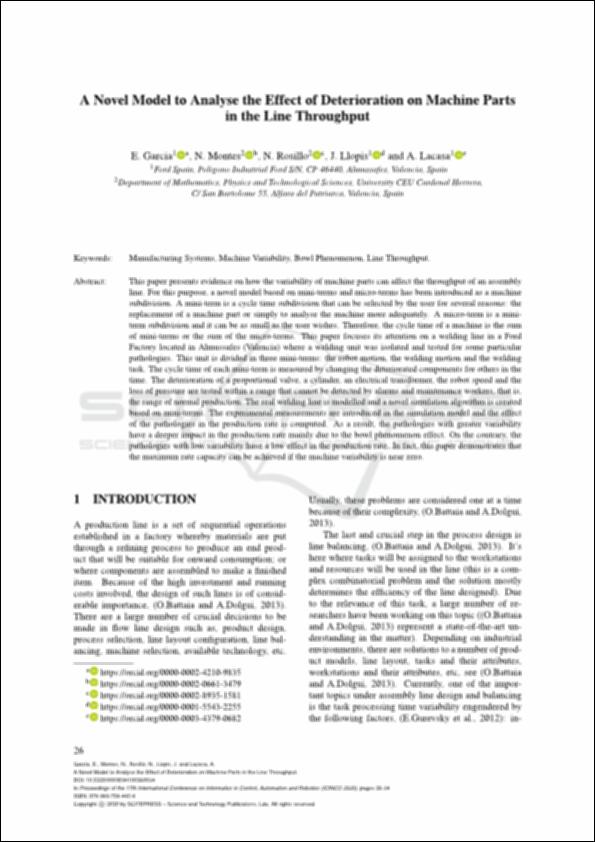Please use this identifier to cite or link to this item:
http://hdl.handle.net/10637/12716A novel model to analyse the effect of deterioration on machine parts in the line throughput
| Title: | A novel model to analyse the effect of deterioration on machine parts in the line throughput |
| Authors : | García Magraner, Eduardo Andrés Montés Sánchez, Nicolás Rosillo Guerrero, Nuria Llopis Ballester, Javier Lacasa Corral, Antonio |
| Keywords: | Automóviles - Fabricación - Teledetección.; Industria del automóvil - Producción.; Automóviles - Producción.; Automobiles - Manufacturing - Remote sensing.; Automobile industry and trade - Production.; Industria del automóvil - Automatización.; Automobile industry and trade - Automation.; Automobiles - Production. |
| Publisher: | Science and Technology Publications. |
| Citation: | Garcia, E., Montes, N., Rosillo, N., Llopis, J. and Lacasa, A. (2020). A novel model to analyse the effect of deterioration on machine parts in the line throughput. In Proceedings of the 17th International Conference on Informatics in Control, Automation and Robotics (ICINCO), pp. 26-34. ISSN 2184-2809. ISBN 978-989-758-442-8. DOI: https://doi.org/10.5220/0009594100260034 |
| Abstract: | This paper presents evidence on how the variability of machine parts can affect the throughput of an assembly line. For this purpose, a novel model based on mini-terms and micro-terms has been introduced as a machine subdivision. A mini-term is a cycle time subdivision that can be selected by the user for several reasons: the replacement of a machine part or simply to analyse the machine more adequately. A micro-term is a miniterm subdivision and it can be as small as the user wishes. Therefore, the cycle time of a machine is the sum of mini-terms or the sum of the micro-terms. This paper focuses its attention on a welding line in a Ford Factory located in Almussafes (Valencia) where a welding unit was isolated and tested for some particular pathologies. This unit is divided in three mini-terms: the robot motion, the welding motion and the welding task. The cycle time of each mini-term is measured by changing the deteriorated components for others in the time. The deterioration of a proportional valve, a cylinder, an electrical transformer, the robot speed and the loss of pressure are tested within a range that cannot be detected by alarms and maintenance workers, that is, the range of normal production. The real welding line is modelled and a novel simulation algorithm is created based on mini-terms. The experimental measurements are introduced in the simulation model and the effect of the pathologies in the production rate is computed. As a result, the pathologies with greater variability have a deeper impact in the production rate mainly due to the bowl phenomenon effect. On the contrary, the pathologies with low variability have a low effect in the production rate. In fact, this paper demonstrates that the maximum rate capacity can be achieved if the machine variability is near zero. |
| Description: | Este artículo se encuentra disponible en la página web de la revista en la siguiente URL: https://www.scitepress.org/Papers/2020/95941/95941.pdf Este artículo pertenece a la 17th International Conference on Informatics in Control, Automation and Robotics (ICINCO 2020) - Online streaming, 7-9 July 2020. |
| URI: | http://hdl.handle.net/10637/12716 |
| Rights : | http://creativecommons.org/licenses/by-nc-nd/4.0/deed.es |
| ISBN: | 9789897584428. |
| ISSN: | 2184-2809. |
| Issue Date: | 7-Jul-2020 |
| Center : | Universidad Cardenal Herrera-CEU |
| Appears in Collections: | Dpto. Matemáticas, Física y Ciencias Tecnológicas |
Items in DSpace are protected by copyright, with all rights reserved, unless otherwise indicated.


